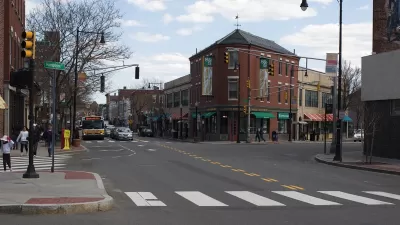After moving forward with parking and zoning reforms, the Berkeley City Council is also considering a new Affordable Housing Overlay on a model previously adopted in Cambridge, Massachusetts.

Berkeley is not resting after taking several significant steps toward planning reform in recent months—first by removing residential parking requirements in most parts of the city and then by voting to rescind single-family zoning.
Berkeley Councilmember Terry Taplin has also sponsored a 100% Affordable Housing Overlay, building on a model provided by a similar overlay approved by Cambridge, Massachusetts in October 2020.
Randy Shaw, who has written on the idea previously for Beyond Chron and in his book Generation Priced Out, details the proposal. Shaw is an obvious proponent of the Affordable Housing Overlay concept, calling it "the best strategy for high housing cost cities to reduce segregation."
How does an affordable housing overlay work? "Cambridge’s Affordable Housing Overlay permits greater height and density for ministerial approval for 100% Below Market-Rate housing developments." Those height and density bonuses "[increase] the availability of infill sites where nonprofit and public entities may otherwise be unable to compete with private developers," according to Shaw, who notes that numerous underutilized commercial parcels in Berkeley would become much more viable for affordable housing development under the proposed changes.
Councilmember Taplin's proposed overlay was scheduled for a hearing before the Berkeley City Council's Land Use Committee on March 4. The Joint Center for Housing Studies at Harvard University is hosting a free webinar on the subject of affordable housing overlays on March 11, exploring the possibility of this planning policy tool's expansion to yet more locations.
FULL STORY: Berkeley's Next Big Step: A 100% Affordable Housing Overlay

Maui's Vacation Rental Debate Turns Ugly
Verbal attacks, misinformation campaigns and fistfights plague a high-stakes debate to convert thousands of vacation rentals into long-term housing.

Planetizen Federal Action Tracker
A weekly monitor of how Trump’s orders and actions are impacting planners and planning in America.

San Francisco Suspends Traffic Calming Amidst Record Deaths
Citing “a challenging fiscal landscape,” the city will cease the program on the heels of 42 traffic deaths, including 24 pedestrians.

Defunct Pittsburgh Power Plant to Become Residential Tower
A decommissioned steam heat plant will be redeveloped into almost 100 affordable housing units.

Trump Prompts Restructuring of Transportation Research Board in “Unprecedented Overreach”
The TRB has eliminated more than half of its committees including those focused on climate, equity, and cities.

Amtrak Rolls Out New Orleans to Alabama “Mardi Gras” Train
The new service will operate morning and evening departures between Mobile and New Orleans.
Urban Design for Planners 1: Software Tools
This six-course series explores essential urban design concepts using open source software and equips planners with the tools they need to participate fully in the urban design process.
Planning for Universal Design
Learn the tools for implementing Universal Design in planning regulations.
Heyer Gruel & Associates PA
JM Goldson LLC
Custer County Colorado
City of Camden Redevelopment Agency
City of Astoria
Transportation Research & Education Center (TREC) at Portland State University
Jefferson Parish Government
Camden Redevelopment Agency
City of Claremont





























